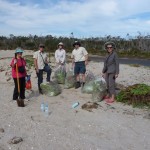
Sea spurge, Euphorbia paralias, is an invasive beach weed that originated from Europe. Sea spurge was probably introduced to Australia in ships’ ballast water about 70 years ago. The plant first appeared in Western Australia and is now found throughout south-eastern Australia, including Tasmania and the islands of Bass Strait. The weed is now in the Gippsland Lakes Coastal Park.
Sea spurge is a problem because each plant can produce up to 5000 salt-tolerant seeds. These seeds can survive for a number of years on ocean currents that spread them from beach to beach. Once established, a sea spurge colony can spread rapidly, displacing the native vegetation and changing the structure of the beach. This can disrupt many native species including the endangered shorebirds (hooded plovers, little terns and oystercatchers) that use open sand spits for nesting.
 Sea spurge can grow anywhere on the beach front, from the high water mark to well into the dunes, and has also been found on rocky foreshores and rock shelves, on the steep back dunes and inside the mouths of coastal lakes and estuaries. It has now been observed at a number of locations inside the Gippsland Lakes, as well as along the coastal side of the Lakes.
Sea spurge can grow anywhere on the beach front, from the high water mark to well into the dunes, and has also been found on rocky foreshores and rock shelves, on the steep back dunes and inside the mouths of coastal lakes and estuaries. It has now been observed at a number of locations inside the Gippsland Lakes, as well as along the coastal side of the Lakes.
 Friends of the Parks and Reserves of the Gippsland Lakes (FoGL), in partnership with Parks Victoria (PV), is undertaking a weeding program at a number of locations within the Coastal Park. The first of these was held at Barrier Landing and Rigby Island on November 20th. Six FoGL members and three PV staff removed the weed from both sides of the coastal track at Barrier Landing, as well as along the lake shore. They were also able to clear a more remote area on Rigby Island.
Friends of the Parks and Reserves of the Gippsland Lakes (FoGL), in partnership with Parks Victoria (PV), is undertaking a weeding program at a number of locations within the Coastal Park. The first of these was held at Barrier Landing and Rigby Island on November 20th. Six FoGL members and three PV staff removed the weed from both sides of the coastal track at Barrier Landing, as well as along the lake shore. They were also able to clear a more remote area on Rigby Island.
Follow up weeding at these sites is planned for the autumn and it is hoped that regular twice yearly maintenance will keep Sea spurge under control, so that it does not become a problem weed in the Park.
